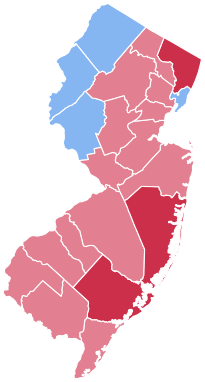United States presidential election in New Jersey, 1916
| | ||||||||||||||||||||||||||||||||
| ||||||||||||||||||||||||||||||||
| ||||||||||||||||||||||||||||||||
|
| ||||||||||||||||||||||||||||||||
| County Results
Wilson—50-60%
Hughes—50-60%
Hughes—60-70% | ||||||||||||||||||||||||||||||||
| ||||||||||||||||||||||||||||||||
The 1916 United States presidential election in New Jersey took place on November 7, 1916. All contemporary 48 states, were part of the 1916 United States presidential election. New Jersey voters chose 14 electors to the Electoral College, which selected the President and Vice President.
New Jersey was won by the Republican nominees, U.S. Supreme Court Justice Charles Evans Hughes of New York and his running mate, former Vice President Charles W. Fairbanks of Indiana. Hughes and Fairbanks defeated the Democratic nominees, incumbent President Woodrow Wilson of New Jersey and his running mate incumbent Vice President Thomas R. Marshall of Indiana.
Hughes carried New Jersey decisively with 54.40% of the vote to Wilson's 42.68%, a victory margin of 11.72%.[1]
Coming in a distant third was Socialist candidate Allan L. Benson, who took 2.10%.
Like much of the Northeast, New Jersey in this era was a staunchly Republican state, having not given a majority of the vote to a Democratic presidential candidate since 1892. However, in 1912, Woodrow Wilson, then the sitting Governor of New Jersey, had won the state's electoral votes, but with a plurality of only 41% in a 3-way race against a split Republican field, with former Republican President Theodore Roosevelt running as a third party candidate against incumbent Republican President William Howard Taft. However, with the Republican base re-united behind Charles Evans Hughes in 1916, Wilson lost his home state to the GOP by a decisive 12-point margin in a head-to-head match-up, despite having served as the state's governor.
On the county level map, reflecting his comfortable victory, Hughes carried 17 of the state's 21 counties, breaking 60% of the vote in 3 of them.
Wilson's only significant win was urban Hudson County, while he also won the 3 rural counties in western North Jersey, Warren, Sussex, and Hunterdon, which had long been Democratic enclaves in an otherwise Republican state.
Despite being Wilson's home state, New Jersey registered as the third most Republican state in the nation in terms of vote share and the fourth most Republican state in the nation in terms of margin, the state being about 15% more Republican than the national average.
| Elections in New Jersey | ||||||||
|---|---|---|---|---|---|---|---|---|
 | ||||||||
|
||||||||
|
||||||||
Results
| United States presidential election in New Jersey, 1916 | |||||
|---|---|---|---|---|---|
| Party | Candidate | Votes | Percentage | Electoral votes | |
| Republican | Charles Evans Hughes | 268,982 | 54.40% | 14 | |
| Democratic | Woodrow Wilson | 211,018 | 42.68% | 0 | |
| Socialist | Allan L. Benson | 10,405 | 2.10% | 0 | |
| Prohibition | Frank Hanly | 3,182 | 0.64% | 0 | |
| Socialist Labor | Arthur E. Reimer | 855 | 0.17% | 0 | |
| Totals | 494,442 | 100.0% | 14 | ||
See also
References
- ↑ "1916 Presidential General Election Results - New Jersey". Dave Leip's Atlas of U.S. Presidential Elections. Retrieved 5 February 2014.
Template:United States elections, 1916



